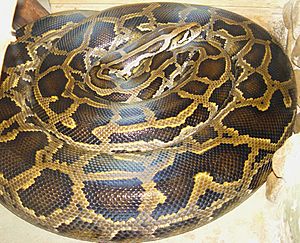Python (genus) facts for kids
Quick facts for kids Python |
|
|---|---|
 |
|
| The Burmese python (Python bivittatus) is a type of python. | |
| Scientific classification |
|
| Kingdom: | Animalia |
| Phylum: | Chordata |
| Class: | Reptilia |
| Order: | Squamata |
| Suborder: | Serpentes |
| Family: | Pythonidae |
| Genus: | Python Daudin, 1803 |
| Synonyms | |
|
List
Python Daudin, 1803
Constrictor Wagler, 1830 Enygrus Wagler, 1830 Engyrus Gray, 1831 Enygris Gray, 1842 Heleionomus Gray, 1842 Morelia Gray, 1842 Hortulia Gray, 1842 Asterophis Fitzinger, 1843 Liasis Duméril & Bibron, 1844 Simalia Gray, 1849 Aspidopython Meyer, 1874 Aspidoboa Sauvage, 1884 Hypaspistes Ogilby, 1891 |
|
Python is a group of snakes known for squeezing their prey. These snakes live in warm, tropical, and subtropical areas of the Eastern Hemisphere. This includes parts of Africa and Asia.
The name Python was first used by François Marie Daudin in 1803. He used it for non-venomous snakes that had spotted skin. Today, scientists recognize 10 different types, or species, of pythons in this group. Some types that were once considered subspecies are now seen as full species.
Contents
Understanding Python Species
The name Python was given to these snakes in 1803. It described snakes that were not venomous, had spotted skin, and a long, split tongue. This was done by François Marie Daudin.
In 1993, seven python species were officially recognized. Now, based on how different species are related (their family tree), scientists recognize between seven and 13 python species. Here are some of the well-known python species:
- The Indian python (P. molurus) lives in parts of Asia.
- The African rock python (P. sebae) is found in Africa. There is also a southern type called the Southern African rock python (P. s. natalensis).
- The Ball python (P. regius) is a smaller python from Africa.
- The Burmese python (P. bivittatus) is a large snake from Southeast Asia.
- The Sumatran short-tailed python (P. curtus) lives in Southeast Asia, including Sumatra.
- The Bornean short-tailed python (P. breitensteini) is found on the island of Borneo.
- The Angolan python (P. anchietae) lives in Angola.
- Brongersma's short-tailed python (P. brongersmai) is found in Malaysia and Sumatra. It was once thought to be a subspecies of P. curtus.
- The Myanmar short-tailed python (P. kyaiktiyo) was discovered more recently in Myanmar.
- An extinct species, Python europaeus, lived during the Miocene era. Its remains, mostly backbones, were found in France.
Where Pythons Live
Pythons live in many parts of the world. In Africa, they are found in the tropical areas south of the Sahara desert. However, they do not live in the very southern tip of Africa or on the island of Madagascar.
In Asia, pythons are found from Bangladesh, Nepal, India, Pakistan, and Sri Lanka. Their range extends through Myanmar, east to Indochina, southern China, Hong Kong, and Hainan. They also live in the Malayan region of Indonesia and the Philippines.
Pythons in New Places
Sometimes, pythons can end up in places where they don't naturally belong. For example, the Burmese python (P. bivittatus) and the African rock python (P. sebae) have become a problem in South Florida. In 2016, officials in Everglades National Park found many pythons. They believe thousands might live there and have been breeding for years. However, newer studies suggest that these pythons might not survive cold winters north of Florida.
How Pythons Are Used
Python skin is used to make different items. These include clothing like vests, belts, boots, and shoes. It is also used for fashion items such as handbags. The skin can also be stretched to form the sound board for some musical instruments. Examples include the erhu (a Chinese fiddle), the sanxian (a Chinese lute), and the sanshin (a Japanese lute).
Pythons as Pets
Many types of pythons are popular pets. This includes the ball python (P. regius), Brongersma's short-tailed python (P. brongersmai), and Burmese python (P. bivittatus). People like them because they are often easy to care for and have calm personalities. Some pythons also have very bright and unique colors. Rare color patterns can even sell for thousands of dollars.
While there have been some stories in the news, owning a pet python is generally safe if you follow proper safety rules. Deaths linked to pet pythons are very rare compared to other common pets like dogs and horses.
The Name Python
The word 'Python' comes from old languages. It comes from the Latin word 'pȳthon' and the Greek word 'πύθων'. Both of these words refer to a famous story from Greek myths. In this myth, the god Apollo killed a giant serpent. This serpent was called Python. The name of the serpent was then used to describe these snakes.
Images for kids
See also
 In Spanish: Python (animal) para niños
In Spanish: Python (animal) para niños










